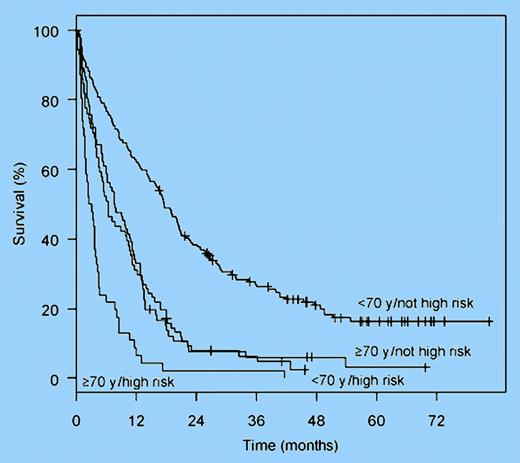Older adults with acute myeloid leukemia respond poorly to chemotherapy, especially if they have poor-risk cytogenetics or are over age 70. The up-front treatment of such patients with molecularly targeted therapies, including FLT3 inhibitors, can yield important biologic and clinical insight.
Patients older than age 55 to 65 who are diagnosed with acute myeloid leukemia (AML) have a small chance of long-term survival due to a combination of poor chemotherapeutic tolerance and inherent disease resitance.1 Patients believed to be appropriate chemotherapy candidates have a median survival of 10 to 12 months and a 3-year overall survival of less than 10%. Can subgroups of patients who are better chemotherapy candidates be identified? Is it reasonable to treat some or all patients with investigational agents as initial therapy?
In this issue of Blood, studies by Fröhling and colleagues and by Knapper and colleagues provide new data regarding some of the thorny issues surrounding the care of older patients with AML. The study by Fröhling et al determines if cytogenetics offer similar prognostic information in older adults with AML compared with the widely used cytogenetic classification system in younger adults, which subdivides those with good-, intermediate-, and poor-risk cytogenetics into disease-free survivals of 65%, 48%, and 15%, respectively.2 The current study involves uniformly treated older adults with AML who were also divided into 3 prognostic categories based on diagnostic cytogenetics. New findings included the fact that t(8;21) fell into the intermediate group (perhaps due to the lack of intensive consolidation chemotherapy) and complex cytogenetics indicated 3 or more abnormalities. This study confirms the small (4%) frequency of nonacute promyelocytic leukemia (treated on separate protocols) goodrisk patients who are older than age 60. Secondly, the intermediate-risk group does quite badly, with a median survival of 1 year. One is left with the question as to whether it is reasonable to treat virtually any patients with intensive chemotherapy. Multivariate analysis disclosed that patients older than age 70 without any prognostic abnormality did as poorly as those who were younger than age 60 with poor prognostic abnormalities (see figure). Certainly these groups of patients are probably not appropriate for chemotherapy but rather for supportive care or nonintensive investigational approaches. Older adults with AML should be informed about the poor outcomes prior to receiving cytotoxic chemotherapy.FIG1
OS based on stratification system and age. See the complete figure in the article beginning on page 3280.
OS based on stratification system and age. See the complete figure in the article beginning on page 3280.
The study by Knapper et al attempts to, in part, determine the value of a FLT3 inhibitor, the indolocarbazole alkaloid CEP-701, in previously untreated adults with AML. Because of ethical concerns, eligibility was restricted to those older than age 70 or between age 60 and 70 with an Eastern Cooperative Oncology Group (ECOG) performance status of 2 or greater. The oral CEP-701 potently inhibits the FLT3 tyrosine kinase known to be mutated in up to 30% of patients with AML. Twenty-five percent have a repeat of 3 to 33 amino acids in the juxtamembrane region (internal tandem duplication [ITD]) and 5% to 10%, a point mutation in the activation loop.3 A FLT3 inhibitor makes sense in mutant FLT3 AML and possibly in those with wild-type FLT3, perhaps because of the relevance of overexpression of FLT3 in such patients or even because of nontarget effects. Previous studies documented biologic responses in mutant FLT3 AML manifested by decrease in bone marrow and/or peripheral blasts.4,5 This study showed a similar level of response in those with mutant disease, but some with FLT3 wild-type AML also responded. The reason for the lack of profound responses even in those with a FLT3 mutation was elucidated by clever ancillary studies involving assays, suggesting that in some cases there was an inadequate FLT3 inhibitory activity in the plasma and in other cases the blasts were intrinsically resistant to the drug. The degree of intrinsic resistance could certainly be explained by reliance on non-FLT3 pathways. The ethics of using a FLT3 inhibitor in this fashion are justified based on the occasional response and the lack of major toxicity, especially in view of the poor prognosis in this group of patients.
In summary, these studies support the initial use of investigational drugs in older patients with AML, particularly those with even worse than the average prognosis based on poor cytogenetics or age older than 70. FLT3 inhibitors will not likely have a role as single agents in even mutant FLT3 AML, but biologic responses observed suggest it might be reasonable to combine other antileukemic agents with FLT3 inhibitors in both mutant and wild-type FLT3 AML.▪


This feature is available to Subscribers Only
Sign In or Create an Account Close Modal